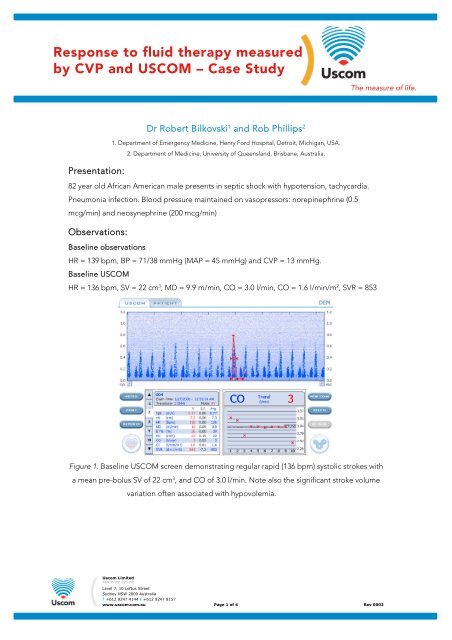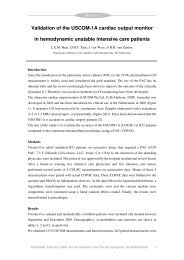Fluid Responsiveness In Irregular Cardiac Rhythms - Uscom
Fluid Responsiveness In Irregular Cardiac Rhythms - Uscom
Fluid Responsiveness In Irregular Cardiac Rhythms - Uscom
Create successful ePaper yourself
Turn your PDF publications into a flip-book with our unique Google optimized e-Paper software.
Response to fluid therapy measuredby CVP and USCOM – Case StudyDr Robert Bilkovski 1 and Rob Phillips 21. Department of Emergency Medicine, Henry Ford Hospital, Detroit, Michigan, USA.2. Department of Medicine, University of Queensland, Brisbane, Australia.Presentation:82 year old African American male presents in septic shock with hypotension, tachycardia.Pneumonia infection. Blood pressure maintained on vasopressors: norepinephrine (0.5mcg/min) and neosynephrine (200 mcg/min)Observations:Baseline observationsHR = 139 bpm, BP = 71/38 mmHg (MAP = 45 mmHg) and CVP = 13 mmHg.Baseline USCOMHR = 136 bpm, SV = 22 cm 3 , MD = 9.9 m/min, CO = 3.0 l/min, CO = 1.6 l/min/m 2 , SVR = 853Figure 1. Baseline USCOM screen demonstrating regular rapid (136 bpm) systolic strokes witha mean pre-bolus SV of 22 cm 3 , and CO of 3.0 l/min. Note also the significant stroke volumevariation often associated with hypovolemia. 2000 Australia<strong>Uscom</strong> LimitedABN 35 091 028 090Level 7, 10 Loftus StreetSydney NSW 2000 AustraliaT +612 9247 4144 F +612 9247 8157www.uscom.com.au Page 1 of 4 Rev 0002
Response to fluid therapy measuredby CVP and USCOM – Case Study<strong>In</strong>terventionThe patient had an infusion of 25 gm of albumin over 20 minutes in response to low CO, CIand SV, a high HR, and hypotension.Post <strong>In</strong>fusion ObservationsHR = 139 bpm, BP = 71/38 mmHg (MAP = 45 mmHg) and CVP = 13 mmHg (unchanged).Post <strong>In</strong>fusion USCOMHR = 115 bpm, SV = 36 cm 3 , MD = 14 m/min, CO = 4.3 l/min, CI = 2.3 l/min/m 2 , SVR = 1141Figure 2. USCOM screen post fluid bolus demonstrating increased SV and CO and adecreased HR. Note also the reduction in stroke volume variation associated with respiration..<strong>Uscom</strong> LimitedABN 35 091 028 090Level 7, 10 Loftus StreetSydney NSW 2000 AustraliaT +612 9247 4144 F +612 9247 8157www.uscom.com.au Page 2 of 4 Rev 0002
Response to fluid therapy measuredby CVP and USCOM – Case StudyFigure 3. USCOM screen of examination trend data demonstrating increased CO, SV, MDand ET% measures from baseline (at left) and the increased post bolus value (onright).Discussion:CVP directed haemodynamic optimization goals of >12 mmHg were satisfied at rest with CVPof 13 mmHg, suggesting no need for fluid infusion. Baseline CO, CI and SV were inadequateas was BP, suggesting the need fro fluid.Post fluid CVP was unchanged at 13 mmHg, while objective flow measurements from USCOMwere significantly increased. SV was increased by 63%, CO by 43% and MD by 41%.Note:MD or minute distance; a cross sectional area independent measure of flow per minute and isthe product of SD (stroke distance is the distance a single red blood cell travels per stroke incm) and HR.ET% is the % ratio of ejection time (ET) to cycle time (1/(heart rate/60)) and is normally 30-35%at normal heart rates.<strong>Uscom</strong> LimitedABN 35 091 028 090Level 7, 10 Loftus StreetSydney NSW 2000 AustraliaT +612 9247 4144 F +612 9247 8157www.uscom.com.au Page 3 of 4 Rev 0002
Response to fluid therapy measuredby CVP and USCOM – Case StudyConclusion:USCOM identified significant SV reserve and SV fluid responsiveness not detectable usinginvasive CVP haemodynamic goals. Appropriate assessment of cardiac output is improved byobjective beat to beat understanding of flow.References:CVP and circulationMichard et al. Chest. June 2002:121(6);2000-2008. Two of five studies showed CVP predicted fluid responsiveness.Michard. AJRCCM 2000:162;134–138.Hofer, C. K., S. M. Muller, et al. "Stroke volume and pulse pressure variation for prediction of fluid responsiveness inpatients undergoing off-pump coronary artery bypass grafting." Chest 2005:128(2);848-54. 25% SVI response to fluiddetected by CVP 0.541Kumar et al. CCM:2004:32:3. Healthy individuals CVP and SVI r=0.322 Brock et al. Eur J Anesthesiology 2002:19:288-294. Severe sepsis before and after bolus baseline delta CI vs CVP, r=0.41, and delta CVP vs delta CI; r = 0.28.SV variability (SVV)Gunn SR, Pinsky MR. Implications of arterial pressure variation in patients in the intensive care. Curr Opin Crit Care2001;7:21Reuter DA, Kirchner A, Felbinger TW, Weiss FC, Kilger E, Lamm P, Goetz AE. Usefulness of left ventricular strokevolume variation to assess fluid responsiveness in patients with reduced cardiac function. Crit Care Med2003;31(5):1399-1403Reuter DA, Bayerlain J, Goepfert MSG, Weiss FC, Kilger E, Lamm P, Goetz AE. <strong>In</strong>fluence of tidal volume on leftventricular stroke volume variation measured by pulse contour analysis in mechanically ventilated patients. <strong>In</strong>tensiveCare Med 2003;29(3):476-480Wiesenack C, Prasser C, Roding G, Keyl C. Stroke volume variation as an indicator of fluid responsiveness using pulsecontour analysis in mechanically ventilated patients.,Anes Analg 2003;96:1254-1257 Tavernier B, Makhotine O,Lebuffe G, et al. Systolic pressure variation as a guide to fluid therapy in patients with sepsis induced hypotension.Anaesthesiology 1998;89:1313- 1321.Michard F, Boussat S, Chemla D, Anguel N, Mercat A, Lecarpentier Y, Richard C, Pinsky M, Teboul JL. Relationbetween respiratory changes in arterial pulse pressure and fluid responsiveness in septic patients with acutecirculatory failure. Am J Respir Crit Care Med 2000;162:134-138.Reuter DA, Felbinger TW, Schmidt C, Kilger E, Goedje O, Lamm P, Goetz AE. Stroke volume variation for assessmentof cardiac responsiveness to volume overloading in mechanically ventilated patients after cardiac surgery. <strong>In</strong>tensiveCare Med 2002;28:392-398Honzokova N, Krticka A, Navakova Z, ZAvodnz E. A dampening effect of pulse interval variability on blood pressurevariation with respect to primary variability in blood pressure during exercise. Physiol Res 2003;52:299-309Feissel M, Michard F, Mangin I, Ruyer O, Faller JP, Teboul JL. Respiratory changes in aortic blood velocity as anindicator of fluid responsiveness in ventilated patients with septic shock. Chest 2001; 119;867-873Constant I, Laude D, Murat I, Elghozi J. Pulse rate variability is not a surrogate for heart rate variability. Clin Science1999;97:391-397Hofer, CK, Muller SM, et al. Stroke Volume and Pulse Pressure Variation for Prediction of <strong>Fluid</strong> <strong>Responsiveness</strong> inPatients Undergoing Off-pump Coronary Artery Bypass Grafting. Chest 2005; 128(2):848-54. Jardin F, Farcot JC, et al.Cyclic changes in arterial pulse during respiratory support. Circulation. 1983;68(2):266-4.<strong>Uscom</strong> LimitedABN 35 091 028 090Level 7, 10 Loftus StreetSydney NSW 2000 AustraliaT +612 9247 4144 F +612 9247 8157www.uscom.com.au Page 4 of 4 Rev 0002




